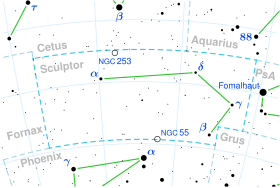Star in the constellation Sculptor
Theta Sculptoris
Observation dataEpoch J2000.0 Equinox J2000.0
Constellation
Sculptor
Right ascension
00 11 44.02079
Declination
−35° 07′ 59.2320″
Apparent magnitude (V)
+5.236±0.005
Characteristics
Evolutionary stage
main sequence
Spectral type
F5V
B−V color index
0.459±0.002
Astrometry Radial velocity (Rv )−21.1±0.3 km/s Proper motion (μ) RA: +171.529 mas /yr Dec.: +126.670 mas /yr Parallax (π)46.1936 ± 0.1565 mas Distance 70.6 ± 0.2 ly pc ) Absolute magnitude (MV )3.52 Details Mass 1.25 M ☉ Radius 1.40±0.05 R ☉ Luminosity 3.09 L ☉ Surface gravity (log g )4.25±0.10 cgs Temperature 6,395±80 K Metallicity −0.07±0.07 dex Rotational velocity (v sin i )1.0±1.0 km/s Age 1.6+2.4Gyr Other designations θ Scl , CD −35°4, FK5 6, GC 202, GJ 3013, HD 739, HIP 950, HR 35, SAO 192388, LTT 79, GSC 06995-01262 Database references SIMBAD data
θ Sculptoris , Latinized as Theta Sculptoris , is a star in the southern constellation of Sculptor . This object is visible to the naked eye as a dim, yellow-white hued star with an apparent visual magnitude of +5.24. It is located 71 light years from the Sun based on parallax . The object is drifting closer with a radial velocity of −21 km/s, and may come to within 49 light-years in half a million years.
According to Fuhrmann and Chini (2015) this is an astrometric binary system, although Eggleton and Tokovinin (2008) deemed it to be a single star. The visible component is an ordinary F-type main-sequence star with a stellar classification of F5V. It is around 1.6 billion years old with 1.25 times the mass of the Sun and 1.40 times the Sun's radius . The star is radiating three times the luminosity of the Sun from its photosphere at an effective temperature of 6,395 K.
References
^ Brown, A. G. A. ; et al. (Gaia collaboration) (August 2018). "Gaia Data Release 2: Summary of the contents and survey properties" . Astronomy & Astrophysics 616 . A1. arXiv :1804.09365 . Bibcode :2018A&A...616A...1G . doi :10.1051/0004-6361/201833051 .Gaia DR2 record for this source at VizieR .
^ Fuhrmann, K.; Chini, R. (2012), "Multiplicity among F-type Stars", The Astrophysical Journal Supplement , 203 (2): 20, Bibcode :2012ApJS..203...30F , doi :10.1088/0067-0049/203/2/30 , 30.
^ Gray, R. O.; Corbally, C. J.; Garrison, R. F.; McFadden, M. T.; Bubar, E. J.; McGahee, C. E.; O'Donoghue, A. A.; Knox, E. R. (2006), "Contributions to the Nearby Stars (NStars) Project: Spectroscopy of Stars Earlier than M0 within 40 pc--The Southern Sample", The Astronomical Journal , 132 (1): 161–170, arXiv :astro-ph/0603770 , Bibcode :2006AJ....132..161G , doi :10.1086/504637 , S2CID 119476992 .
^ Anderson, E.; Francis, Ch. (2012), "XHIP: An extended hipparcos compilation", Astronomy Letters , 38 (5): 331, arXiv :1108.4971 , Bibcode :2012AstL...38..331A , doi :10.1134/S1063773712050015 , S2CID 119257644 .
"tet Scl" . SIMBAD Centre de données astronomiques de Strasbourg . Retrieved 2019-09-03.{{cite web }}: CS1 maint: postscript (link )
Fuhrmann, K.; Chini, R. (August 2015), "Multiplicity among F-type stars. II", The Astrophysical Journal , 809 (1): 19, Bibcode :2015ApJ...809..107F , doi :10.1088/0004-637X/809/1/107 , 107.
Eggleton, P. P.; Tokovinin, A. A. (September 2008), "A catalogue of multiplicity among bright stellar systems", Monthly Notices of the Royal Astronomical Society 389 (2): 869–879, arXiv :0806.2878 , Bibcode :2008MNRAS.389..869E , doi :10.1111/j.1365-2966.2008.13596.x , S2CID 14878976 .
Categories :
Theta Sculptoris
Add topic
Text is available under the Creative Commons Attribution-ShareAlike License. Additional terms may apply.
**DISCLAIMER** We are not affiliated with Wikipedia, and Cloudflare.
The information presented on this site is for general informational purposes only and does not constitute medical advice.
You should always have a personal consultation with a healthcare professional before making changes to your diet, medication, or exercise routine.
AI helps with the correspondence in our chat.
We participate in an affiliate program. If you buy something through a link, we may earn a commission 💕
↑
